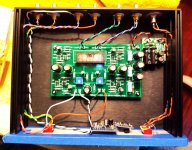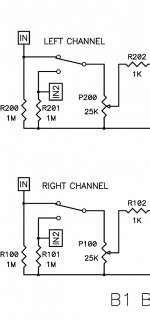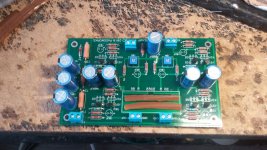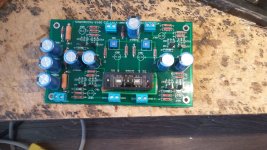Finally received all the parts I need and getting ready to wire the Korg pcb together with the Academy Audio volume control. I have included an SMPS filter that I received from Monk55, and a +/- 12V power supply for the volume control.
The volume control pcb interconnect points are inline and on .1" centers. I'm looking for ways to reduce wiring, especially to those VCU pads, and would like some advice on ground connections.
It seems to me that all grounds, without exception, eventually wind up connected to the pcb trace that runs around the outside of the board. Given that fact, is there a need for all the ground wires related to the inputs and the output to all follow the hot leads they are associated with, or can they be "shortest distance" connected to the nearest grounding pad on the pcb?
And, can the VCU signal grounds be simply connected to the pcb ground at the front of the pcb with the input grounds connected to the pcb ground at the back of the pcb?
As for the power ground, it seems to me that it needs to run to the front panel to power the LED (and, in my case, the +/- 12V supply) but does it also have to run all the way back per the switch wiring instructions? Can the ground simply be used as it comes into the chassis -- through the SMPS filter -- then to the pcb?
Scratching my head over how this might affect signal quality.
Over the last 3 months, I've the following mods added to my B1:
1. Changed the six Nichicon FW signal coupling caps to Nichicon Muse ES.
2. Replaced the volume knob with TKD (same 50K ohm pot from Parts Connexion).
3. Replaced the 24v SMPS with a LPS I bought from eBay. It is one of those "Studer900" LPS with a 30VA R-Core transformer.
The Muse ES does offer more balanced sound and a more revealing mid-range. They do require 2+ weeks to break-in, and I got loss of bass sometime in week 2. I think if 6L6 is putting together more kits for sales in the future, I don't see why we're still using the FW caps.
TOM: When we put together kits, we have to contend with a lot of compromises and try to use the highest quality parts that also
get the job done. While your choice of caps is often a personal preference
that might suit your tastes, when building hundreds or more of the
kit often means for example, that the quantities we need to assemble all of the kits must be available in those quantities. Often the designer
interacts often with the kit builders here so you can be assured that
no one is throwing in terrible parts. So in the end, if you prefer something
else, swap it out or assemble your own BOM and build it from scratch.
That is the beauty of DIY !
The TKD volume knob does remove some sibilance in the sound which is a surprise to me. It is able to render some nuances that I haven't heard before.
The eBay Studer900 supply is a total surprise to me. I think these guys have borrowed some kind of regulation circuit from a Studer mixing console. Anyway, the supply is remarkably good sounding for the amount I paid. It has a 30VA R-Core transformer and is already using Schottky rectifiers. The only thing I've to replace in the LPS is the Chinese made RM cap with a Panasonic TSHA cap.
The important thing to know is that it is not the DC side of the SMPS that is not good enough. The 3-stage RC circuit in B1 is effective in reducing the noise for any SMPS. It is the noise a SMPS dumps to the AC side and that noise is picked up from sensitive audio equipment (ie: your DAC). I have SMPS powering other devices that are not in the audio chain, but happen to share the same wall outlet. Just by unplugging these SMPSes have improved the sound - wider and more holographic sound stage and more analog sound.
TOM: Have you tried inserting this between the SMPS and the B1K?
PO89ZB , an inline DC filter for SMPS wall warts . Preamps, HPA, Korg NuTube, etc
It measures out REALLY well, and some (myself included) have experimented with using two in series.
So I'm in the process of eliminating all SMPS, and replacing them with LPS using a simple LT1083 regulator. That should be more than good enough for this purpose. Some eBay sellers are offering 10-15% off LPS sales until March 24th. So I picked up 3 more 50VA R-Core LPS for $89 each including shipping.
If you are interested in using an LPS, take your DIY one step further and
build your own. The Sigma22 is one of the lowest ripple/noise supplies I've
ever built and I'm using mine on my B1K now as a comparison to using Mark's SMPS filter on the SMPS I built for it too. You can find the sigma22 here and AMB does sell kits that include most of the parts/boards too:
The σ22 regulated power supply
--Tom
Thanks! Am about to insert the Korg into my system, will replace the resistor after the test.
Plugged it in, turned on the music. Right channel sounded good, left channel - nothing. Oh, no.
Discovered if I unplugged the good channel, the bad channel would play. If I plugged in both, the left channel died.
Thought it was a crossed ground and, yes, thank goodness, cross-wired the left channel output, ground-to-hot, easy fix. Now playing just fine, and it surely does sound good.
Recently, someone posted about passive volume control impedances not matching power amp impedances. Got curious since I was using a naked LDR volume control, looked up my power amp impedance (class d amp) -- it was 15K! Korg not only makes my system sound sweeter, but now I have much better bass, courtesy of better impedance matching. I need to look into adding a B1 buffer to my LDR pot which is still my favorite and most versatile.
I'll give it a day or so playing the Korg with an outboard LDR volume control, then on to wiring the Academy Audio volume control which is installed but not wired.
Attachments
Congrats, Berkbear!
It was the cold solder. Thanks for the help JSiz.
Persistence pays off!!
Adversity is a great teacher!
Have been listening to my Korg for a day now, I'm very happy with the sound.
The "snap" sound when switching inputs is pretty loud and in my system it's not microphonics, it's definitely electrical and it comes from the speakers. (BTW, nothing I can do causes any microphonics of any kind in my system.)
Honestly, for me and my system this switch is pretty much redundant as is the power switch but I don't like living with issues that I could fix if I understood them. The relay switching system I had in front of my passive volume control did not generate this kind of noise, there must be an electrical difference between relays and this DPDT switch, maybe switch bounce?
The "snap" sound when switching inputs is pretty loud and in my system it's not microphonics, it's definitely electrical and it comes from the speakers. (BTW, nothing I can do causes any microphonics of any kind in my system.)
Honestly, for me and my system this switch is pretty much redundant as is the power switch but I don't like living with issues that I could fix if I understood them. The relay switching system I had in front of my passive volume control did not generate this kind of noise, there must be an electrical difference between relays and this DPDT switch, maybe switch bounce?
Last edited:
Have been listening to my Korg for a day now, I'm very happy with the sound.
The "snap" sound when switching inputs is pretty loud and in my system it's not microphonics, it's definitely electrical and it comes from the speakers. (BTW, nothing I can do causes any microphonics of any kind in my system.)
Honestly, for me and my system this switch is pretty much redundant as is the power switch but I don't like living with issues that I could fix if I understood them. The relay switching system I had in front of my passive volume control did not generate this kind of noise, there must be an electrical difference between relays and this DPDT switch, maybe switch bounce?
Solder 1M Ohms resistors to the switch like show on the Papa schematic
Attachments
Solder 1M Ohms resistors to the switch like show on the Papa schematic
Where is this schematic located?
Great! Thank you. That little piece of information would be beneficial for Korg builders, too. Can it somehow be added to the information?
Well, heck. Just implemented the 1 meg resistors and I don't hear any change.
Last edited:
Great! Thank you. That little piece of information would be beneficial for Korg builders, too. Can it somehow be added to the information?
Well, heck. Just implemented the 1 meg resistors and I don't hear any change.
OK, after playing with it -- switching the switch back-and-forth numerous times after installingthe 1M resistors -- it has gotten quieter but still audible. Does that make it a mechanical issue involving the switch contact condition?
Maybe a little lower value - you might have a little DC leakage from the source.
I will try that. Perhaps 500K or is that too low?
I will try that. Perhaps 500K or is that too low?
47K to 500K. Try what you got.
I've got my Korg B1 mostly populated. I'm about to install the Nutube and I had the thought of using a split piece of silicone surgical tube as a anti-microphonic aid. If it doesn't work there will be room between the tube and board to try something else.
Attachments
I've got my Korg B1 mostly populated. I'm about to install the Nutube and I had the thought of using a split piece of silicone surgical tube as a anti-microphonic aid. If it doesn't work there will be room between the tube and board to try something else.
Before I received my Nutube my mind wandered through a wealth of ways to reduce microphonics but in the end I used the double sided sticky foam that came with the tube and it works great for me. I am unable to generate any microphonics of any kind no matter where I tap on the case, on the pcb, on the tube itself.
In addition to the foam I did install rubber spacers between the pcb and the chassis -- the kind used for radio-controlled model airplanes. But I think the foam connection of the Korg to the pcb is the main thing.
- Home
- Amplifiers
- Pass Labs
- B1 with Korg Triode



